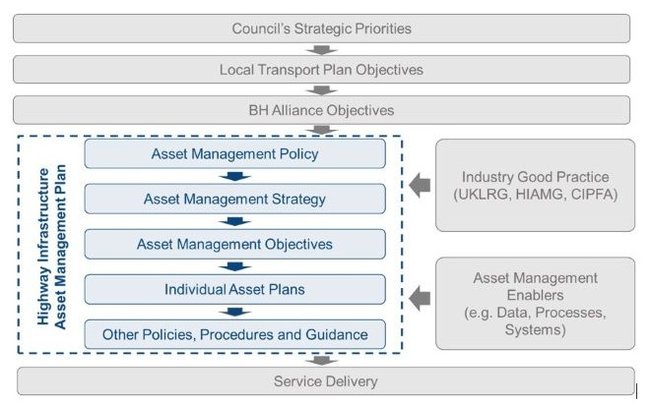Highway Infrastructure Asset Management Plan (HIAMP)
Asset Management Framework
Buckinghamshire’s HIAMP is composed of a suite of interrelated documents that collectively define the council’s approach to asset management. The diagram below illustrates the framework, showing the hierarchy of documents and line of sight between the council’s strategic priorities and Buckinghamshire Highways' Highway Policies, Asset Management Strategy, Asset Plans, and other supporting documents.

Asset Management Policy
Buckinghamshire Highways’ Asset Management Policy outlines the council’s commitment to the effective management of Buckinghamshire’s highways assets, setting the principles that guide decision-making and direct the vision for the highway network in line with the council’s broader corporate objectives, local transport plan (LTP5) and strategic goals. The policy is endorsed by Cabinet and is also referenced in the Council’s Corporate Plan, reinforcing its alignment with the council’s long-term priorities and governance framework.
Asset Management Strategy
The Council’s Asset Management Strategy translates the high-level commitments of the Asset Management Policy into a practical, long-term approach for managing Buckinghamshire’s highway infrastructure. It ensures a clear line of sight from the objectives outlined in the council’s Strategic Plan to the works programmes implemented and delivered each year as part of the council’s business planning and delivery processes. The approach we adopt in our strategy is consistent with the UKRLG Code of Practice and Highway Infrastructure Asset Management Guidance and is supported by a set of asset management enablers, including data, processes, and systems.
The strategy is formally approved by senior management and the Cabinet Member and outlines how Buckinghamshire Highways will deliver its asset management objectives. It provides the framework for making informed, consistent, and transparent decisions about maintaining, renewing, and investing in highway assets over time. It is also the core document that fulfills the requirements of a typical HIAMP, detailing our approach to performance management, asset information and data, investment planning, risk, and overall roles and responsibilities.
Individual Asset Management Plans
The Asset Management Policy and Strategy are supported by a set of individual Asset Plans, which are more tactically focused and provide details of the approaches used for managing the different asset classes in the medium-term that Buckinghamshire Highways are responsible for, including:
- carriageways
- footways and cycleways
- structures
- streetlighting
- Intelligent Transport Systems (ITS)
Each plan is tailored to the characteristics, risks, and performance requirements of the asset type it covers. However, the general structure of the individual Asset Plans is consistent; each containing information regarding:
- risks and opportunities
- asset inventory
- historic asset information
- survey strategies
- asset condition
- maintenance strategies/treatment types
- lifecycle planning and optioneering
- prioritisation and works programming
- risk management and resilience
- performance management
Individual Asset Plans are approved by the Asset Manager and are used to inform decision making and budget discussions. They are not intended to communicate our approach to the public.
Highway Safety Inspection Policy
The Highway Safety Inspection Policy defines the inspection regime for the highway network, including frequencies, defect categorisation, and response times. It ensures that safety-related defects are identified and addressed in a timely and consistent manner, supporting the council’s duty to maintain a safe highway.
Highway Services Policy
The Highway Services Policy outlines the principles and standards for delivering highway services across Buckinghamshire. It defines how the council maintains and improves the highway network, ensuring that services are customer-focused, efficient, and aligned with statutory responsibilities. The policy supports consistent service delivery and underpins the council’s commitment to maintaining a safe and accessible transport network.
Network Safety Policy
The Network Safety Policy sets out the council’s approach to managing safety risks on the highway network. It includes the identification, assessment, and mitigation of safety concerns, with a focus on reducing collisions and improving outcomes for all road users. The policy supports a proactive, data-led approach to safety management and aligns with national road safety objectives.
Network Management Policy
Buckinghamshire Highways manages the operation and use of the highway network in accordance with the Network Management Policy in order to minimise disruption and maintain efficient movement. This document defines our approach to coordination of street works, incident response, and congestion management, ensuring compliance with the Traffic Management Act 2004. The policy promotes a balanced and resilient network that supports economic activity and community wellbeing.
Winter Service Policy
The Winter Service Policy sets out how the council prepares for and responds to winter weather conditions. It includes the prioritisation of gritting routes, snow clearance procedures, and communication protocols. The policy ensures that key routes remain safe and accessible during adverse weather, supporting public safety and the continuity of essential services.
Resilient Network Plan
The Buckinghamshire Highways Resilient Network Plan 2025 | Buckinghamshire Council identifies key routes that are critical for maintaining connectivity during extreme weather events or other emergencies. It outlines the council’s approach to prioritising these routes for maintenance, treatment, and recovery, ensuring continuity of access for emergency services, key infrastructure, and essential travel. This plan also outlines the contributions of Buckinghamshire Highways to the council’s wider resilience efforts and activities.